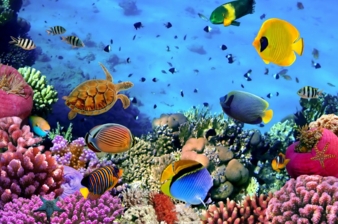30/01/2020 – Lower microplastic pollution during washing — auf Deutsch lesen
Niederrhein University presents preliminary findings
With the aid of a washing and filtering lab on campus, Niederrhein University is working to determine how washing behaviour influences the emission of microplastics.
A project currently under way at the Niederrhein University Research Institute for Textiles and Clothing is exploring how the emission of particles smaller than 5mm can be reduced during the washing of synthetic textiles.
During washing, these small particles, often referred to as microplastics, are rinsed from the washing machine through sewage plants, sludge and surface water all the way into the oceans. A group of female scientists from Mönchengladbach recently presented their preliminary results at a conference in Brussels. One of their findings: most micro particles are emitted the first few times a new piece of clothing is washed.
Professor Ellen Bendt:
“This implies that loose fibre fragments from production processes are still attached to the product, which are only removed during the first few domestic washes.” A possible solution would be an additional processing step that takes place immediately after production (e.g. a prewash or predrying phase).
Especially a predrying step would offer multiple advantages: both the item’s volume and handle, which are very important sales factors, would be affected less severely than if they were washed. This is a solution that would be implemented at the beginning of the product lifecycle.
And how can consumers contribute when using their product?
Ellen Bendt explains that loading the washing machine to the maximum permissible amount is recommended. Their experiments have shown that microplastic emissions to the aquatic environment were at their lowest when clothes were first washed in a full washing machine and subsequently dried in a tumble dryer.
Niederrhein University not only researches the causes of microplastic emissions but also looks into the development of outdoor and sports garments that emit lower levels of microplastics from the start. They have identified two approaches, which would apply to different phases of the textile production chain.
Malin Obermann, project research assistant, explains:
“High levels of microplastic pollution occur during the knitting process in the production halls of fabric manufacturers. Initial experiments with our own large-diameter circular knitting machine have shown that we only need to change two parameters to reduce the emission of small particles significantly.” There are also promising approaches for garment manufacturers in the subsequent making up of fabrics into fleece jackets and hoodies.
The scientists of Niederrhein University discussed their findings with representatives of European textiles associations, the European Commission, science and industry. Their research project “Textile Mission”, funded by the German Federal Ministry of Education and Research, will continue until September 2020.
It is a collaborative effort between Niederrhein University, adidas AG, Polartec LLC, TU Dresden, Vaude Sport GmbH & Co. KG and WWF Germany.





